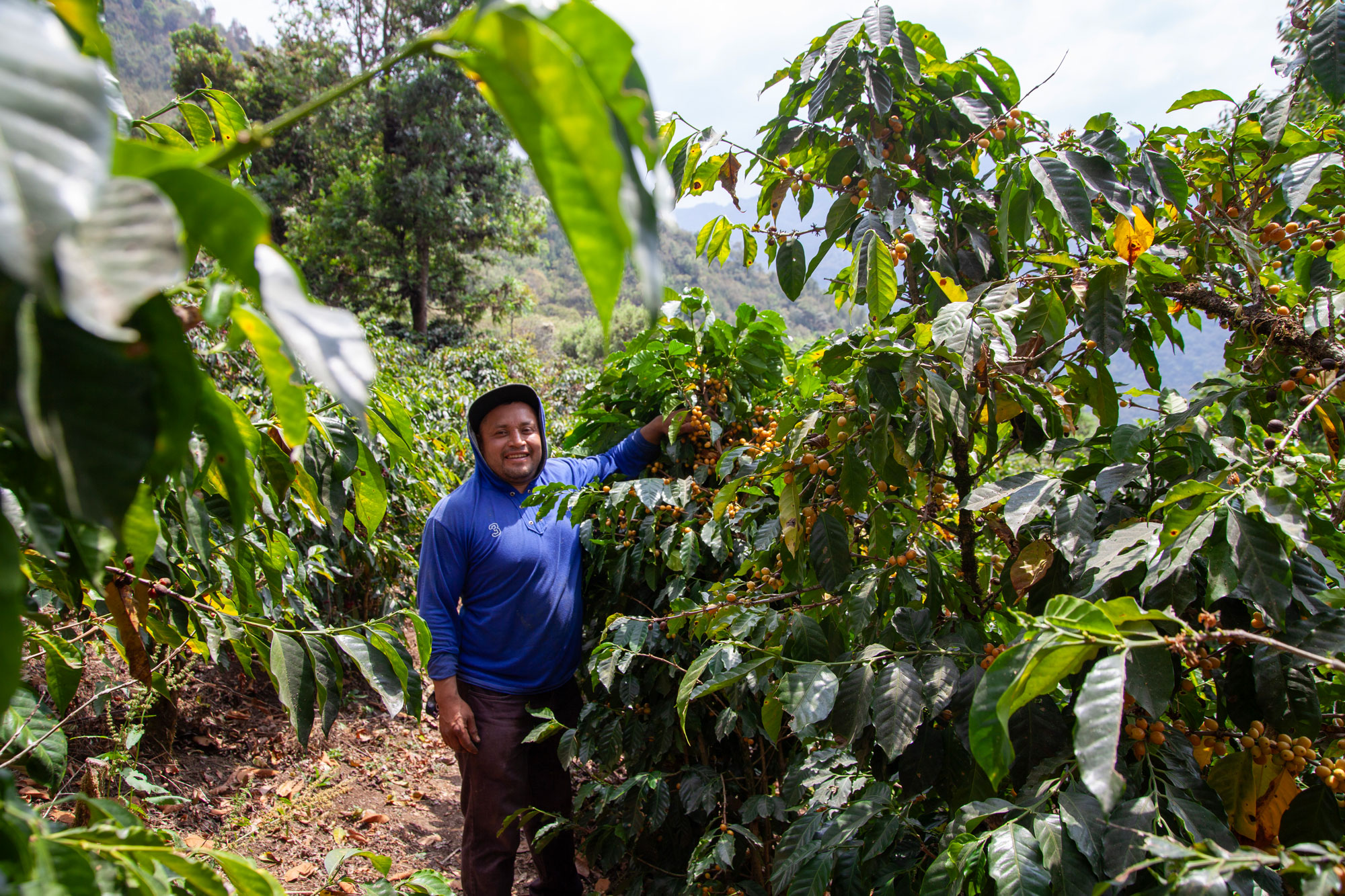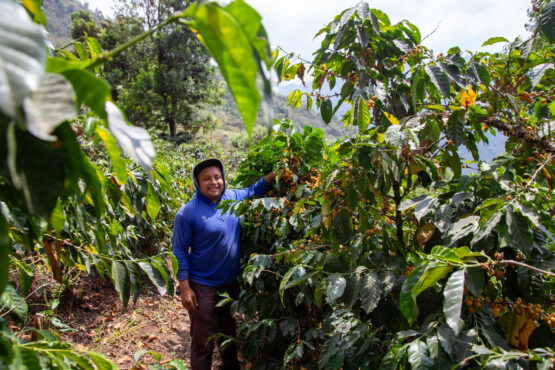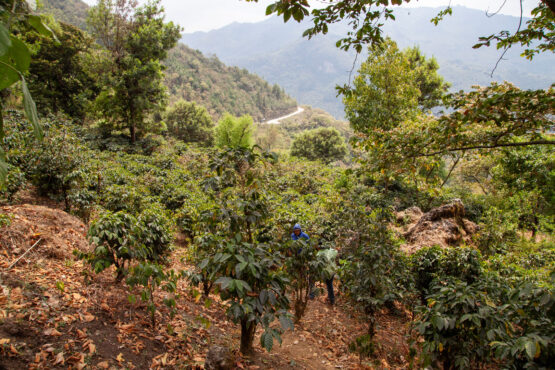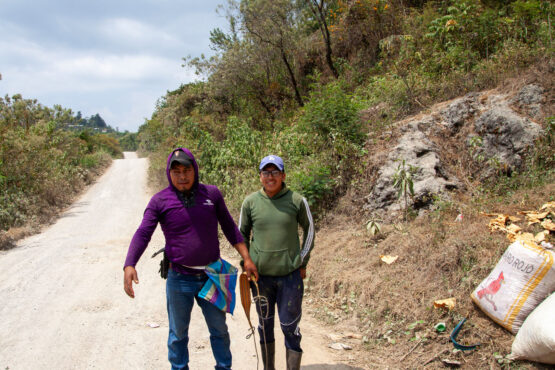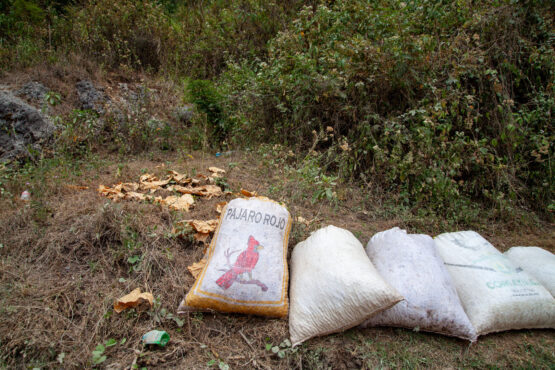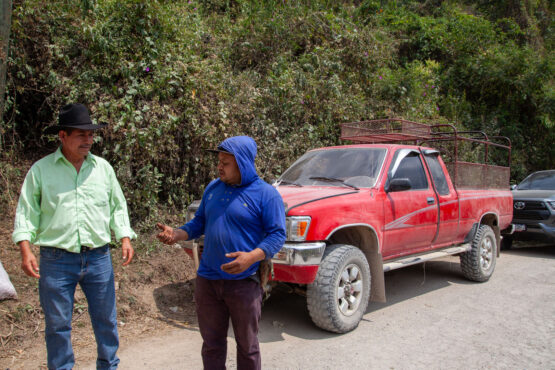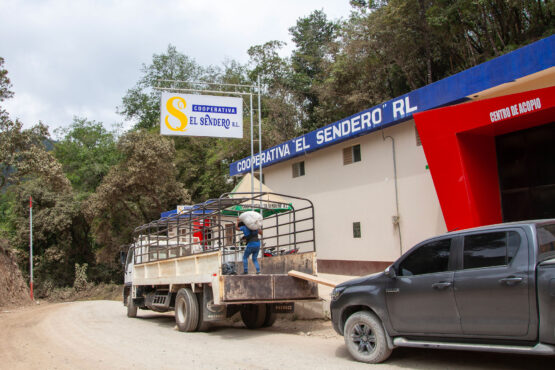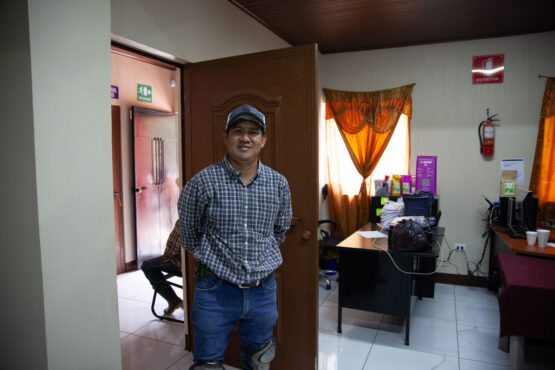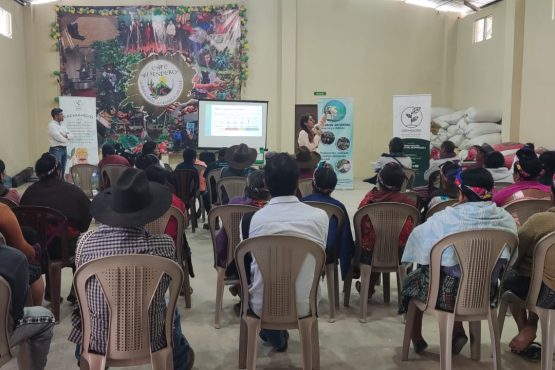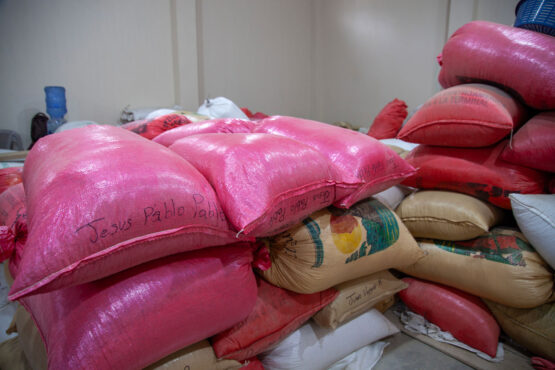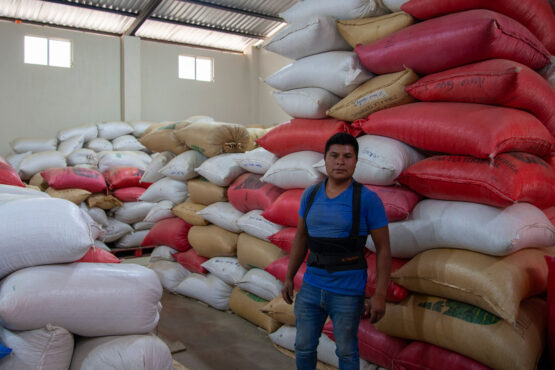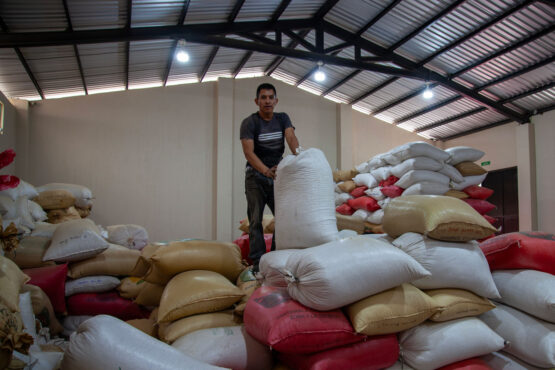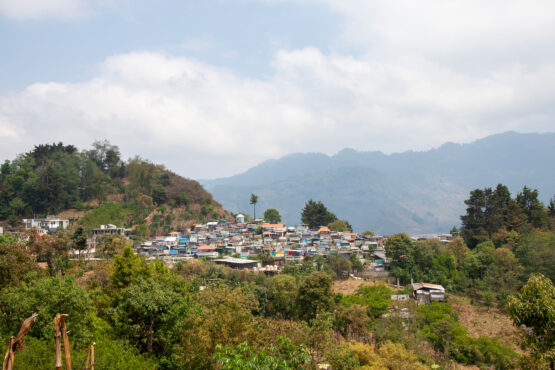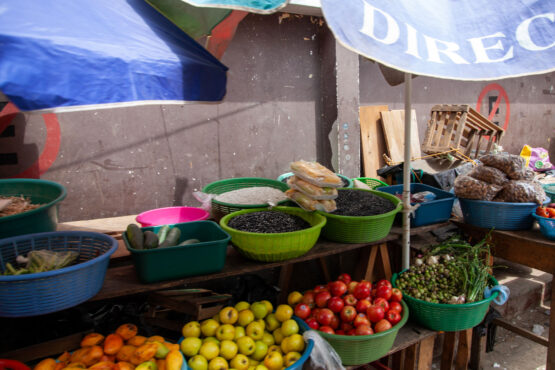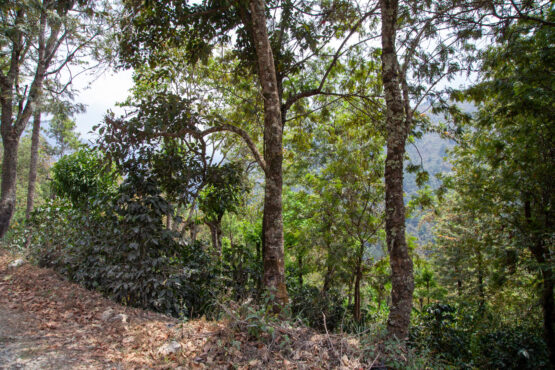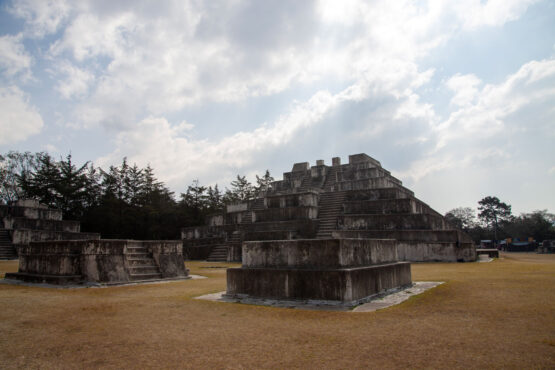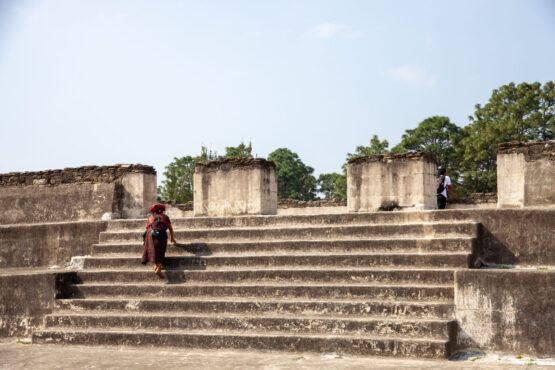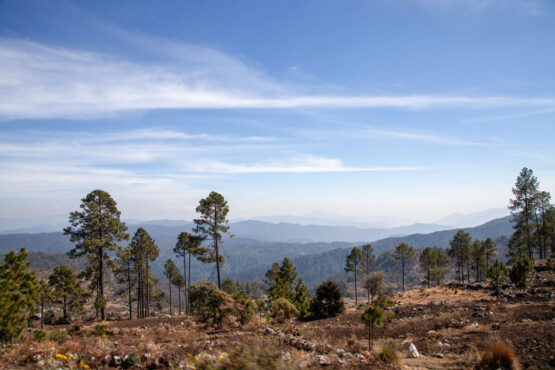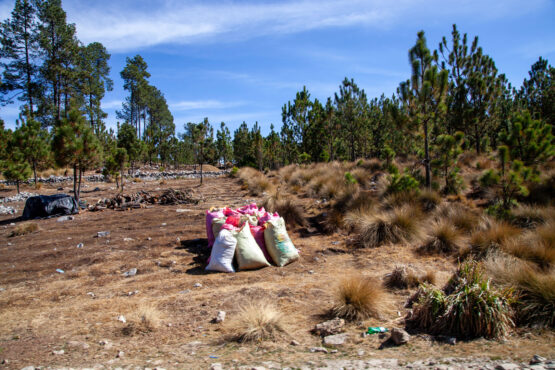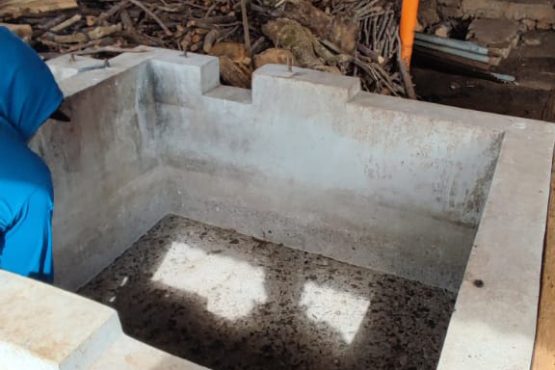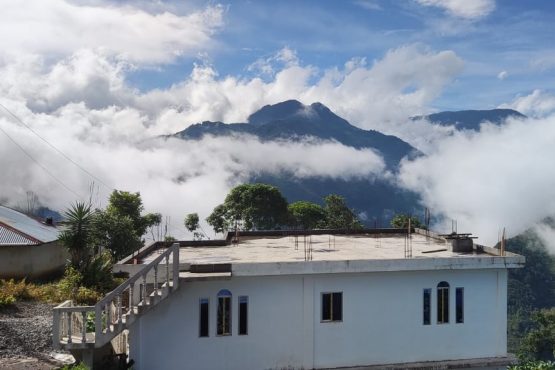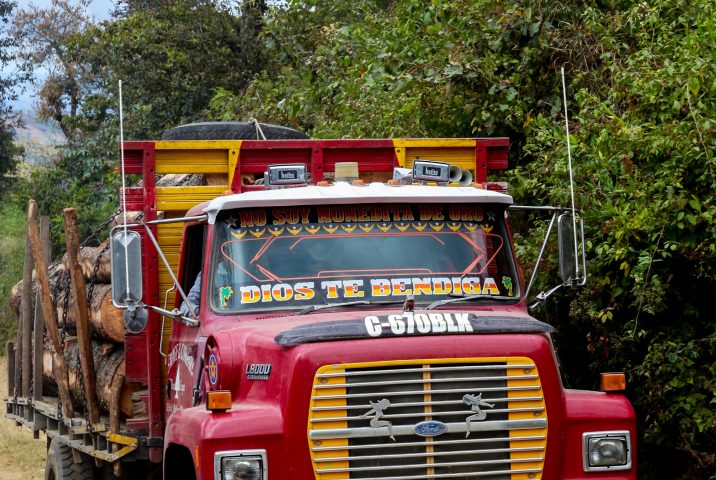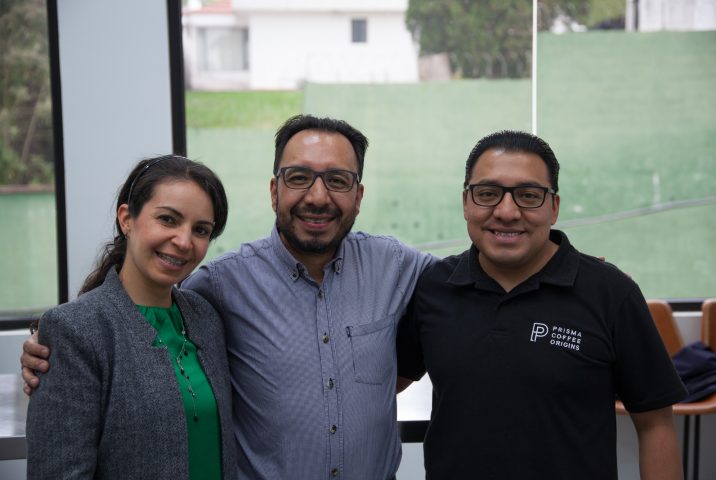Guacamaya
Complex, transparent and lifted with a caramel sweetness, and pretty florals. Pineapple, white grape and nectarine.
This coffee was produced by second-generation farmer Nery Pablo López at his farm Guacamaya. Located at 1,900m above sea level, Guacamaya is nestled in the hills that surround the small town of Ajul, in the municipality of Concepción Huista, in the state of Huehuetenango, Guatemala.
Nery has lived in Concepción Huista his whole life, and has been involved in coffee production from a very young age. He inherited the land Guacamaya sits on when he was only twenty years old, after being established as a coffee farm by his dad Lauriano Pablo. When he first took over the property, Nery noticed a guacamaya (a type of macaw bird commonly found in the region) frequented his parcel of land, and decided to name the farm after it. While his dad still helps with the milling and drying of the coffee produced, Nery is in charge of operations. In the years since he has owned Guacamaya, he has been able to expand it to just over four hectares in size, and has acquired a plot at lower elevations where he farms coffee for the commercial market.
Today, Nery lives a few kilometres away from Guacamaya with his parents, three sisters, wife Victoria and two young daughters. Together, they also grow beans and maize that the family sell through the El Sendero Cooperative. The Pablos have benefited greatly from joining the co-op, as their crop has improved in quality and volume since becoming members in 2021. Not only is the family earning a better income, but they have developed a genuine sense of connection and trust with the cooperative and the buyers they work with. This was really evident when we first visited Guacamaya in early 2024, as an excited Nery told us, “We care about coffee because we get to meet you, we get to meet the people who drink our coffee. Because of this visit, I know things are done right by the co-op.”
Like most farmers in the region, Nery benefits from abundant freshwater, thanks to the local Rio Azul (Blue River) and its tributaries. All coffee at Guacamaya is grown under the shade of Chalum trees (a local variety of Inga) and Gravilea, though the amount of shade needs to be managed carefully every year due to Huehue’s humid, temperate climate. The coffee, beans and maize Nery grows are also intercropped with other fruit trees like avocados, lemons, oranges, and peaches.
Guacamaya is mainly planted with the traditional Red Bourbon and Yellow Caturra varieties, with Pache introduced in more recent years. This lot is 100% Caturra. Nery farms with traditional techniques and organic practices, as is common in the region. Coffee pulp is recycled and dried to be used as fertiliser, and sedimentary tanks are employed to treat the water used during processing. All weeding is done manually, and few chemical pesticides or fertilisers are utilised—though fungicide is applied before flowering, to prevent roya outbreaks. The coffee is selectively hand-harvested, with most labour being provided by Nery and his family.
This exceptional lot was sourced with the help of export partner Eduardo Ambrocio and the team at Prisma Coffee Origins. Eduardo, who is also a Head Judge for Cup of Excellence, is one of the best cuppers we know — and through his work in Guatemala, we are connected to several quality-focused producers, who grow coffee at a small to medium scale. Head here to learn more about Eduardo’s work in Guatemala.
ABOUT EL SENDERO COOPERATIVE
Founded in 2018, the El Sendero Cooperative has a deep connection to Concepción Huista’s farming community. What began as a project with 33 founding members, now includes over 700 contributing farmers (400 of whom are coffee producers) who are led by managing director Pablo Gaspar, who is deeply passionate about ensuring local coffee growers receive fair and timely compensation for their crop. Before founding El Sendero, Pablo was a coffee producer himself. Life for the Gaspar family was challenging because Pablo would only receive partial payment for his crop on delivery (typically in March/April), and then in full several months down the track — sometimes as late as August. At the time, he had been volunteering as part of the management team for a coffee association that supported farmers in HueHue, that was founded using a grant from a local government program. Once those funds ran out, Pablo and a handful of his colleagues began discussing the option of starting their own co-operative, to ensure every farmer member received the financial support needed to establish a successful coffee farm. As Pablo told us on our most recent visit, “We figured, if banks can provide funds for average joes, why can’t we provide the same service to our own farmers?”
And so, Pablo set out to find farmers willing to invest enough capital to start the cooperative. He knew the minimum requirement was eighteen, and he initially had a hard time convincing more than fifteen of his colleagues to join. As the deadline for their application drew nearer, an influential member of the town decided to show her support for the initiative, turning the tide for Pablo and El Sendero. Once the co-op was officially up and running, more local farmers began to deposit their savings into the cooperative, earning them a better interest and strengthening El Sendero’s finances, which in turn benefited members who needed support. Today, the El Sendero’s finances are very healthy because of how quickly their contributor numbers have swelled. To join, farmers only have to pay a 250 Quetzal fee (around $50 AUD), which gets deposited into the cooperative’s general funds. Members then have access to the organisation’s financing, social programs, technical advice and support, and low-cost fertiliser and farming inputs.
When the co-op set up their coffee program in 2019, they lacked the resources and infrastructure to compete with the coyotes (or middlemen) that would roam the town’s streets offering farmers cash on the spot for their cherry. As Pablo explained, “We didn’t have offices or warehouses, so we rented a house in town and stored as much coffee as we could because we knew selling to coyotes was not good business for farmers.” As the co-op grew, they received a grant that helped them build facilities in 2022, where they established a warehouse, cupping lab and roastery. The warehouse includes a set of digital scales, which has furthered bolstered the trust members have on the co-op.
Besides providing its members with financial services and yearly training sessions on the best agricultural practices to follow, El Sendero roasts and distributes its members’ coffee locally. The co-op has also invested time and resources into creating a richer sense of community among its members by regularly organising farmers markets, soccer tournaments, and fairs. When we asked Pablo how El Sendero has found so much success in a seemingly short period of time, he proudly boasted, “because our town grows the best coffee in HueHue!”
By partnering with exporters like Prisma Coffee Origins, who in turn connects them to buyers like MCM, El Sendero has guaranteed its members with the financial stability the local coyotes never could. Pablo and Prisma’s founder Eduardo Ambrosio connected through a common acquaintance at Anacafe (Guatemala’s coffee institute) in early 2023, which led to a very fruitful meeting at El Sendero’s offices in Concepción Huista in March. Eduardo and brother Edwin, who oversees the company’s QA program, recognised the huge potential for quality in the lots they cupped, and were impressed by the traceability offered and the meticulous selection and quality control practices in place. El Sendero, which is Spanish for the path or trail, is an apt name for the cooperative, as their efforts and forward-thinking approach are leading the way to a brighter future for Concepción.
ABOUT CONCEPCIÓN HUISTA
The region of Concepción Huista has been a settlement of the Jakalteko people since before the Spanish invasion of Guatemala. After the Spaniards’ arrival and conquest, the area was integrated into the larger Jacaltenango municipality. After refusing to contribute funds to the building of the local church, they separated and officially became their own municipality in 1672. Locally, Jacaltenango is known as Xajlaj, which translates to “place of the big white rock slabs,” in reference to the plateau overlooking Mexico that the town sits on.
The Jakalteko are one of Guatemala’s 22 Mayan people groups, and due to Jacaltenango’s remote location, they have also historically been one of the country’s most isolated communities. Up until the mid 1970s, a trip to the municipality involved a two-day, 72 km walk from Huehue’s capital—and electricity only came to the town in 1979. Due to this, the Jakalteko have been able to keep many of their customs intact and nearly 80% of the municipality’s population is fluent in the Jakalteko Mayan language.
Because of its prodigious soil and climate, the people of Concepción Huista have always been involved in agriculture, and today a staggering 97% of its inhabitants make a living from it. Coffee is particularly well-suited to the region—as recent as twenty years ago, the crop was able to grow without the need for fertilisers or other inputs, though this is no longer the case due to the effects of climate change. Over the last decade, mining multinationals have pushed to establish gold mines to exploit the region’s mineral-rich soils. The community has banded together and fought hard against this, as they know it would have resulted in serious environmental damage to the tributaries that lead to the Azul River, Huista’s main fresh water source.
ABOUT HUEHUETENANGO
Huehuetenango (or HueHue as it is often called) is a stunning region located in the west of Guatemala near the border with Mexico. HueHue is known for being home to the Cuchumatanes mountain range, the highest non-volcanic mountain range in Central America, and for its vast ethnic diversity, which includes the Mam, Q’anjob’al, Chun and Jakalteko people. Before the Spanish invasion, the region was known as Xinabajul, which translates to “between ravines” in the local Mam language and is a reference to the numerous cliffs and steep hills found throughout the department. Pre-colonisation, the region’s largest city was Zaculeu (found in the outskirts of modern Huehue City), which translates to “white earth,” and whose ruins can still be visited today.
The department is vast, and includes a number of types of terrain that are suited to different forms of agriculture, depending on the elevation. Corn is the main staple of the lower regions, which transitions into coffee the further up one goes, with local pine farmed throughout the entire department. Huehue’s coffee-growing regions produce some of the most complex and celebrated lots in the country, and the region frequently appear in the top ten of the Cup of Excellence competition. This is in part due to the incredibly high elevations that coffee can grow (up to 2,000m above sea level), thanks to the dry, hot winds that blow into the mountains from Mexico’s Tehuantepec plain and protect the region from frost. These high elevations combined with a relatively predictable climate make for exceptional quality coffee. The highest elevations in Huehue, above 2,100m above sea level, are quite dry and rocky, so most farmers dedicate themselves to growing potatoes and herding sheep, goats and llamas.
HOW THIS COFFEE WAS PROCESSED
Nery has established a microbeneficio (small wet mill) with raised beds onsite, which allows him to process and dry his coffee onsite. As a member of the El Sendero Cooperative, Nery also receives training sessions at the beginning of every harvest, to go over the best practices to follow during the picking and processing of his coffee – which are key in the production of exceptional coffee.
Harvest activities at Guacamaya began in February. Because most cherry was hand-picked by Nery and his relatives, a lot of care went into the selection of each bean, and multiple passes were required. Coffee was pre-fermented in sacks for up to 24 hours early in the harvest, though this time shortened to 12 hours once the weather began to warm up in March.
Cherries were then washed and depulped, and left to ferment overnight (or up to 12 hours). The following day, this wet parchment was washed again using fresh water from the nearby Río Azul, and laid to dry on Guacamaya’s concrete patio. Drying until beans reached an adequate and stable moisture content took around a week, and was determined by weather conditions.
Once coffee was dry, it was picked up by the El Sendero Cooperative, where lots were stored at their warehouse and separated based on quality at their cupping lab. Once approved by Prisma’s team, farmers were paid within the week of their crop being sold, and parchment was milled and prepared for export near Guatemala City. Prisma are hoping to build their own dry mill in the coming years, as a way to minimise risk and give them more control of the quality of the coffees they export.
